Last updated on March 28th, 2024
Featured image: There is much to discover for a curious traveller in Canterbury | Photo by A G Baxter on Shutterstock
Five curiosities that make Canterbury magical
by Carolyn Ray
When it comes to picturesque British towns and villages, Canterbury, Kent, in southeast England, comes to mind immediately. This small city of less than 70,000 is a popular year-round destination, with museums, gardens, boating, wineries and Kent’s annual Canterbury Festival in October. In December, it’s just as charming and the perfect time to escape the crowds, with Christmas lights displays, the Whitefriars Christmas market, carols at Canterbury Cathedral and garland-covered boutique shops.
Once a Roman settlement, Canterbury has enormous historical importance as the seat of the spiritual head of the Church of England for nearly five centuries. It might be most famous for its grand Christ Church Canterbury Cathedral, where the troublesome Archbishop Thomas Beckett was slain during the reign of Henry II in 1170. Canterbury Cathedral, St Augustine’s Abbey and St Martin’s Church are part of a UNESCO World Heritage Site that is associated with the introduction of Christianity to the Anglo-Saxon kingdoms. However, there is more than meets the eye here, in a city where martyrs, miracles and myths seem to go hand-in-hand.
With its history and lore, Canterbury has inspired many a pilgrimage and story. Perhaps the most famous is The Canterbury Tales, by poet and author Geoffrey Chaucer, known as the ‘father of English literature’. This compilation of 24 stories in Middle English verse is about a group of pilgrims that travel from London to visit the shrine of Thomas Beckett at Canterbury Cathedral. Canterbury is also the setting for Charles Dickens’ novel David Copperfield, which includes no less than 17 Canterbury sites. including the Sun Inn and the Buttermarket Square.
Curiosity #1: The Romans in Canterbury
Canterbury is an ancient city, dating back 2,000 years. Archaeologists have found remains from the Iron Age, when Belgic tribes settled in large round houses near the River Stour. With the arrival of the Romans in 55 BC, Canterbury began to grow and even had one of the largest theatres in Britain in the early third century. (Source: Canterbury Museum)
Surprisingly, Roman ruins were discovered only in the last several decades, in the 1950s. Located on a side street near Canterbury Cathedral, the Canterbury Roman Museum was built around the remains of a large Roman townhouse excavated after the Second World War. Inside the museum are two rare cavalrymen’s swords, a mosaic floor from a house in Butchery Lane, and many artifacts including pottery, bowls, lamps, jewelry, and painted wall plaster.
There were Roman baths on the site of the current Marlowe Arcade, an open forum beneath High Street, and a large theatre at the southern end of St. Margaret’s Street. While Canterbury is walled, this was built in the Middle Ages on the foundations of the Roman walls.
Roman Canterbury was likely abandoned and fell into ruin, but no one really knows why.
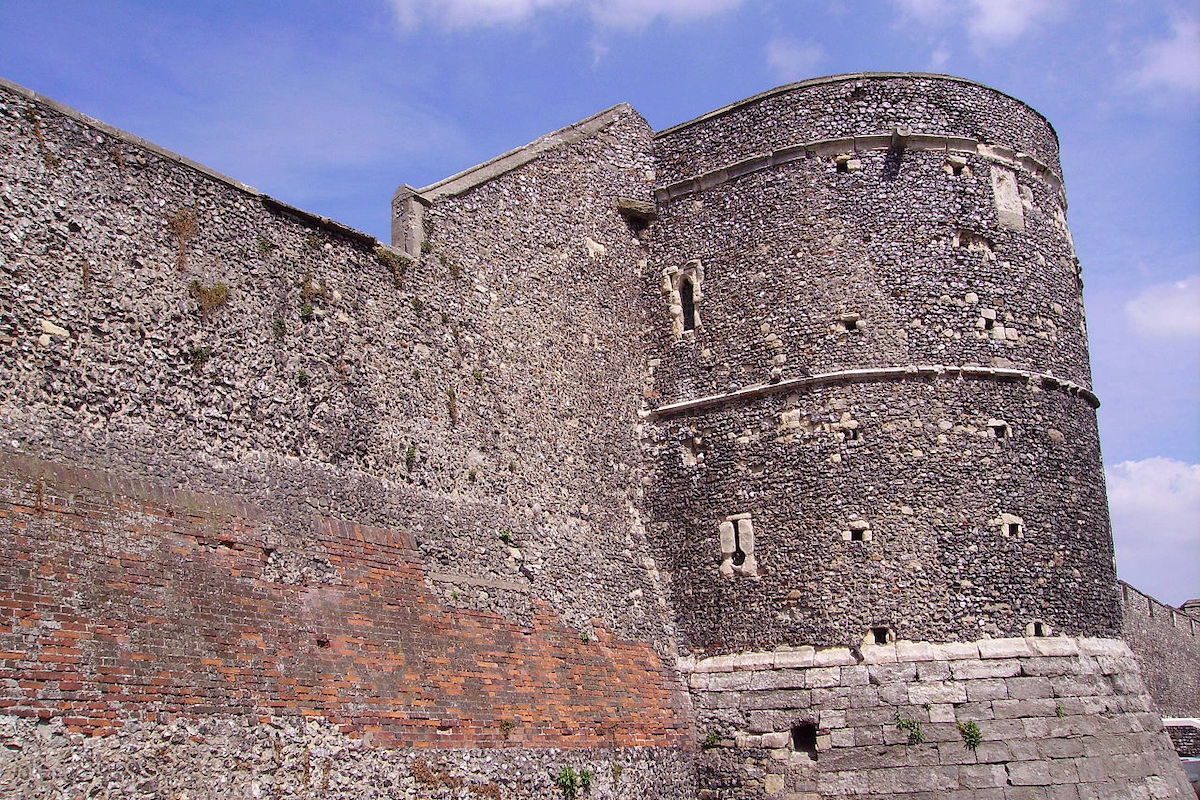
Medieval Roman walls in Cantebury / Photo by Immanuel Giel via Wikimedia Commons
Curiosity #2: Queen Bertha’s influence on Canterbury
Canterbury may be famous in modern times because of Beckett, but the Canterbury Cathedral may not have existed at all without a woman. That woman was Princess Bertha, daughter of Charibert King of Paris. Around 567, Bertha married King Aethelbert, a Pagan who ruled Kent and much of southern England as far west as Brighton and as far north as London.
“It was a political alliance, but as part of the marriage settlement she was allowed to retain her Christian faith,” says my guide, Dr. Robert Gill. “King Aethelbert renovated an old Roman church just outside the city for her use. The latter part of the Roman rule of Britain saw the adoption by the empire of Christianity as one of its official religions and it is possible that a Christian church or shrine stood somewhere within what are now the precincts of the modern cathedral.”
According to Dr. Gill, it is not unreasonable therefore to attribute the establishment of Canterbury Cathedral, at least in part, to Queen Bertha. She was instrumental in the conversion of Ethelbert to the Christian faith (in fact, he was the first Anglo-Saxon king to do so) and the construction of Canterbury and other monastic settlements.
“Bertha’s contribution to the establishment of both the cathedral and of Christianity in England is recognised in the building itself with both a statue and a stained-glass window,” he says.
Dr. Gill says there have been many other women in the life of the Cathedral who have played a major role in the development of the building and its contents. These range from wealthy benefactresses to seamstresses and more recently priests and bishops. Two-thirds of the current (260) staff of Canterbury Cathedral are female.
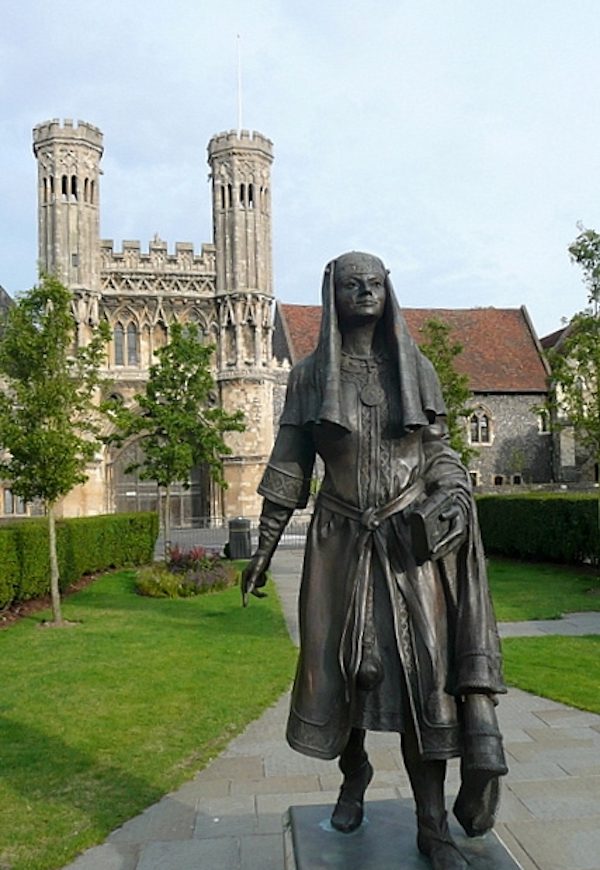
A statue of Queen Bertha outside the cathedral / Photo by Graham Horn via Wikimedia Commons
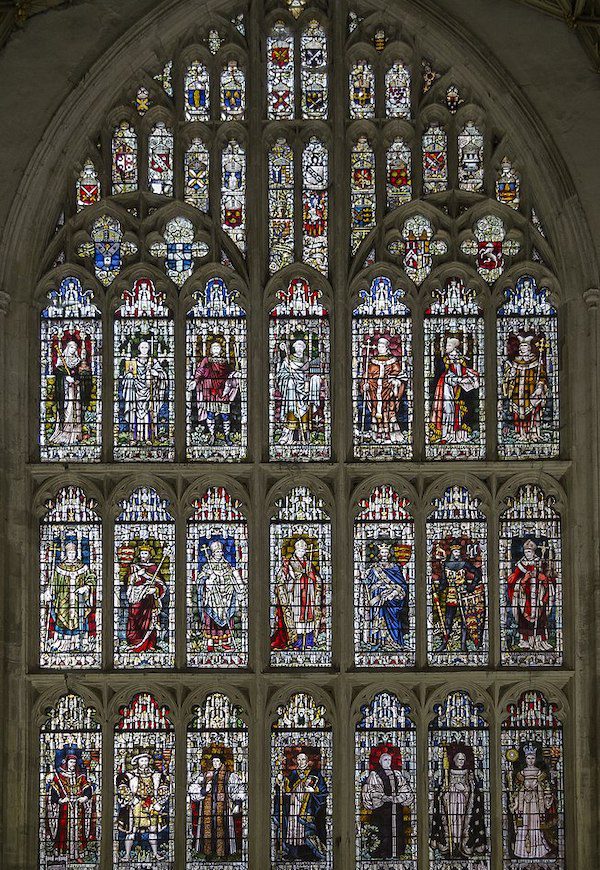
Stained glass with Britain’s kings and queens / Photo by Jules & Jenny, via Wikimedia Commons
Curiosity #3: Where is Thomas Beckett’s body?
My only memory of my last visit to Canterbury almost 40 years ago is of standing on the marble stone in Canterbury Cathedral where Thomas Beckett was famously murdered in 1170 by the knights of Henry II, after he reportedly said: “Will no one rid me of this meddlesome priest?”
Today, that spot is marked by four swords to represent four knights who ‘accidentally’ decapitated him. Beckett’s last words were: “For the name of Jesus and the protection of the Church, I am ready to embrace death.” Fearing his remains might be taken by the knights, monks moved his body several times within the crypt.
Two monks, William and Benedict, recorded 703 miracles while his body was in the crypt, including the cure of leprosy, blindness and paralysis. The miracles spread like wildfire around the world, and his tomb, which became a place of pilgrimage. On February 21, 1173, Pope Alexander III proclaimed Thomas Becket a saint, making Canterbury Cathedral one of the great pilgrimage sites of Europe.
“In 1538, Henry the 8th had the chapel destroyed,” says Dr. Gill. “Beckett’s bones were then put on trial and when found guilty of treason, his bones were, according to tradition, burnt and then blasted from a cannon so as to remove the possibility of further veneration. However, there is no official record of any of this happening and it may just be that the bones were literally thrown away or re-interred in an unmarked grave.”
However, Dr. Gill says rumours and legends at the Cathedral hint at another outcome.
“This is that the monks swopped Beckett’s bones for those of another long-dead individual and thus retained the saint’s remains in secret” he says. “This would have been a dangerous and potentially fatal action had they been found out. Thus, any such act would have remained a secret which perhaps died when the perpetrator died. Indeed, there are several locations within the building where Beckett’s bones might still be resting.”
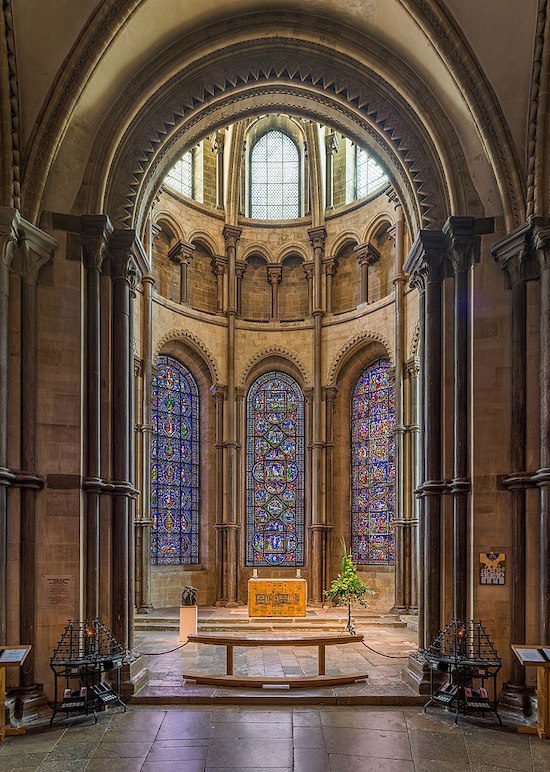
Becket’s Crown, the easternmost point of Canterbury Cathedral / Photo by Diliff via Wikimedia Commons
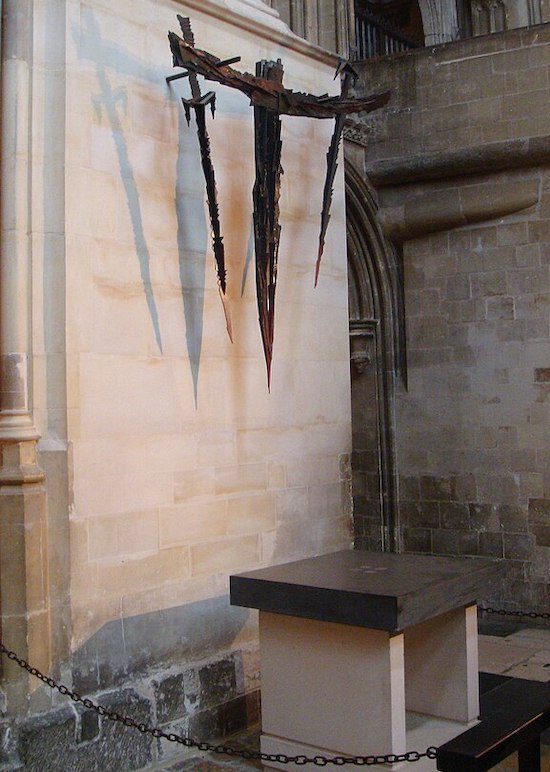
Four swords and an altar marking the spot of Thomas Becket’s martyrdom / Photo by Angelsfan27000 via Wikimedia Commons
Curiosity #4: The Fire Watchers of Canterbury Cathedral
In the Second World War, Canterbury was on the direct route of German bombers flying from French bases to bomb London. The city was bombed several times because bombers couldn’t reach London and just jettisoned the bomb loads as they returned to bases. However, some deliberate bombings did occur.
“Following the RAF raid on Cologne in early June 1942, the German bombers then targeted places of cultural importance in Britain in what was known as the Baedeker raids,” says Dr. Gill. “These included Canterbury, where severe damage was done to the city on the night of October 31, 1942. There were many casualties and much property damage. Although the Cathedral was not hit directly by a high explosive bomb, the library and archives were destroyed.”
In an act of heroism, courageous men and women were lookouts for oncoming planes and dealt with the many incendiary devices that landed on the roof.
“Throughout the war period civilian ‘Fire Watchers’ spent every night on the roof of the Cathedral and doused the incendiaries with water or sand, or threw them off the roof,” Dr. Gill says. These courageous individuals now have a memorial stone set into the floor of the nave.
Curiosity #5: Dickens and Canterbury
While Charles Dickens didn’t live in Canterbury, he visited often and stayed at The Sun Hotel, which he used as the setting for Mr. Micawber’s ‘Little Inn’ in the novel David Copperfield, where he sat waiting ‘for something to turn up’.
Set just outside the gates of Canterbury Cathedral, the seven-room Sun Hotel was originally a large Pilgrim’s hostel built by Christ Church Priory in 1437-38. Dickens’ room is at the top of a narrow set of stairs, with a four-poster bed that the owners say is original. The room has two bathrooms, one very small with a toilet, and another with a sink and shower. As a writer, I’d love to stay there the next time I visit and see if the ghost of Dickens pays me a visit!
The life of Charles Dickens is celebrated in nearby Rochester every December, with entertainment, displays, parades, live music and period costumes. Learn more here.
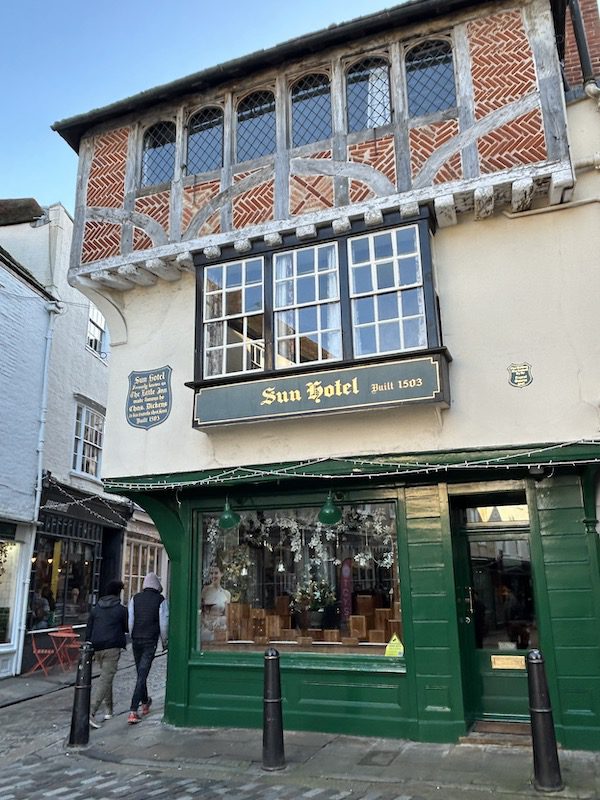
The outside of The Sun Hotel in the old part of Canterbury / Photo by Carolyn Ray
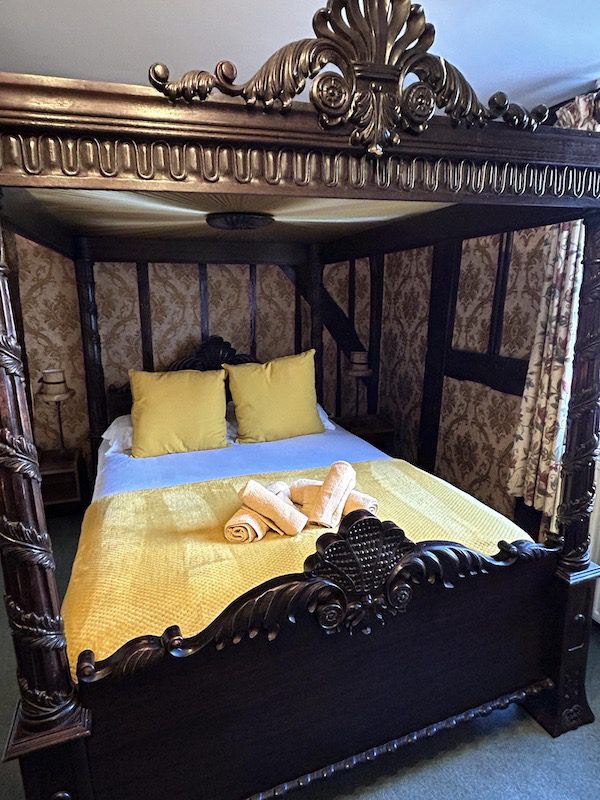
Charles Dickens’ room in the Sun Hotel / Photo by Carolyn Ray
More curiosities for a longer stay
After reading The Alice Network, a best-selling novel about women spies during WW2, I wanted to visit the ports of Folkstone and Dover on the English Channel, and take a trip to Lille, France. By ferry, it’s only about 50 kilometres (or 30 minutes) to France. There are three companies that travel from Dover to Calais several times a day, or you can take the Eurostar train from London. (Find a trip here)
Dover’s prehistoric history
Dover is a charming town, with a quaint high street, including St. Mary’s Church. The Dover Museum houses the Bronze Age Boat Gallery, with the world’s oldest known sea going boat. Discovered in 1992, this prehistoric wooden boat is believed to be some 3,500 years old. The Roman Painted House is the best-preserved Roman house in Britain. Built about AD 200, it formed part of a large mansion for travellers crossing the Channel. Keep in mind it’s only open from April to October.
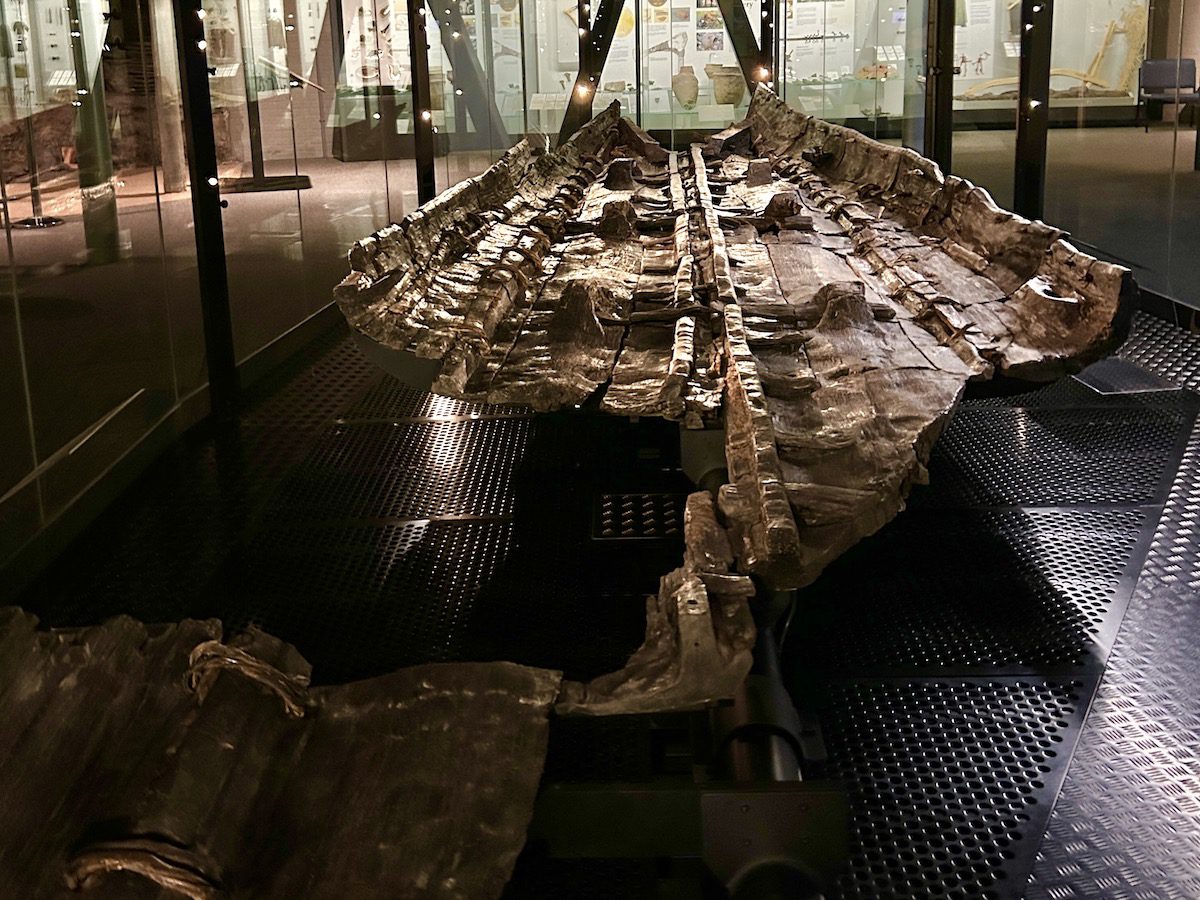
The world’s oldest known seagoing boat, from the Bronze Age, in The Dover Museum / Photo by Carolyn Ray
Folkestone’s historic harbour
During World War 1, the harbour played a key role, shuttling troops and refugees back and forth. There’s a now defunct metal swing bridge, marking the end of an integrated rail/sea/rail service that launched between London and Paris via Folkestone – Boulogne in 1849. There’s a lot of history here. For example, in December 1915, the spy Margaretha Geertruida Zelle ( ‘Mata Hari’ ) was stopped from boarding a ship from Folkestone Harbour to France.
I love harbours at low tide, and here the tide rises about 22 feet, making for some picturesque photos of boats on the ocean floor. Restaurants and shops line the pier, making it the perfect place to enjoy a sunny day. In the historic fishing area, the Folkstone Fishing Museum is nestled under the arches on The Stade. Just a short walk away and a steep walk up or down to the harbour is Folkestone Creative Quarter, a brightly coloured urban village of designers, filmmakers, musicians, web developers and artists. Check opening times in the off season.
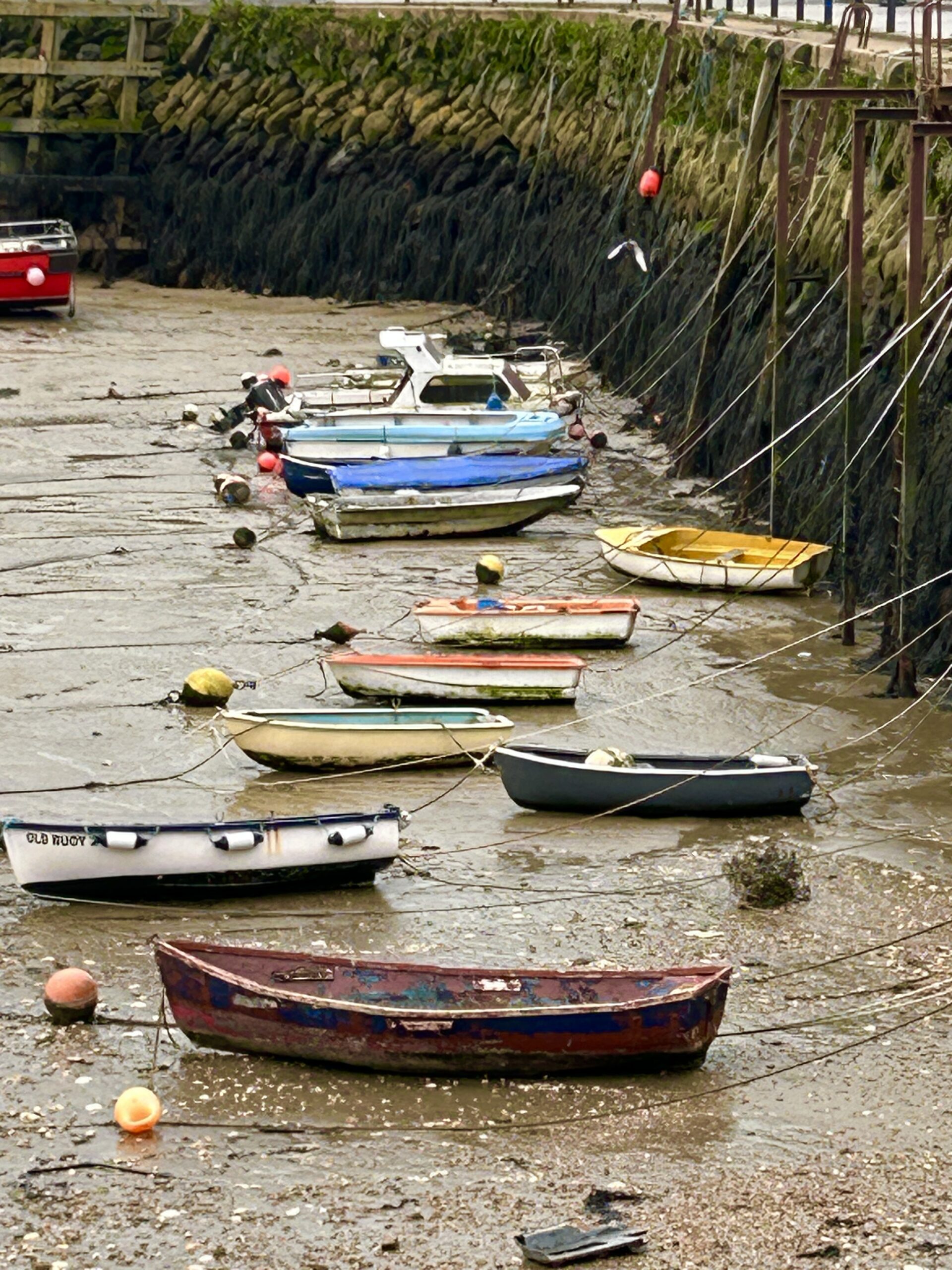
Boats waiting for the spring at Folkstone Harbour / Photo by Carolyn Ray
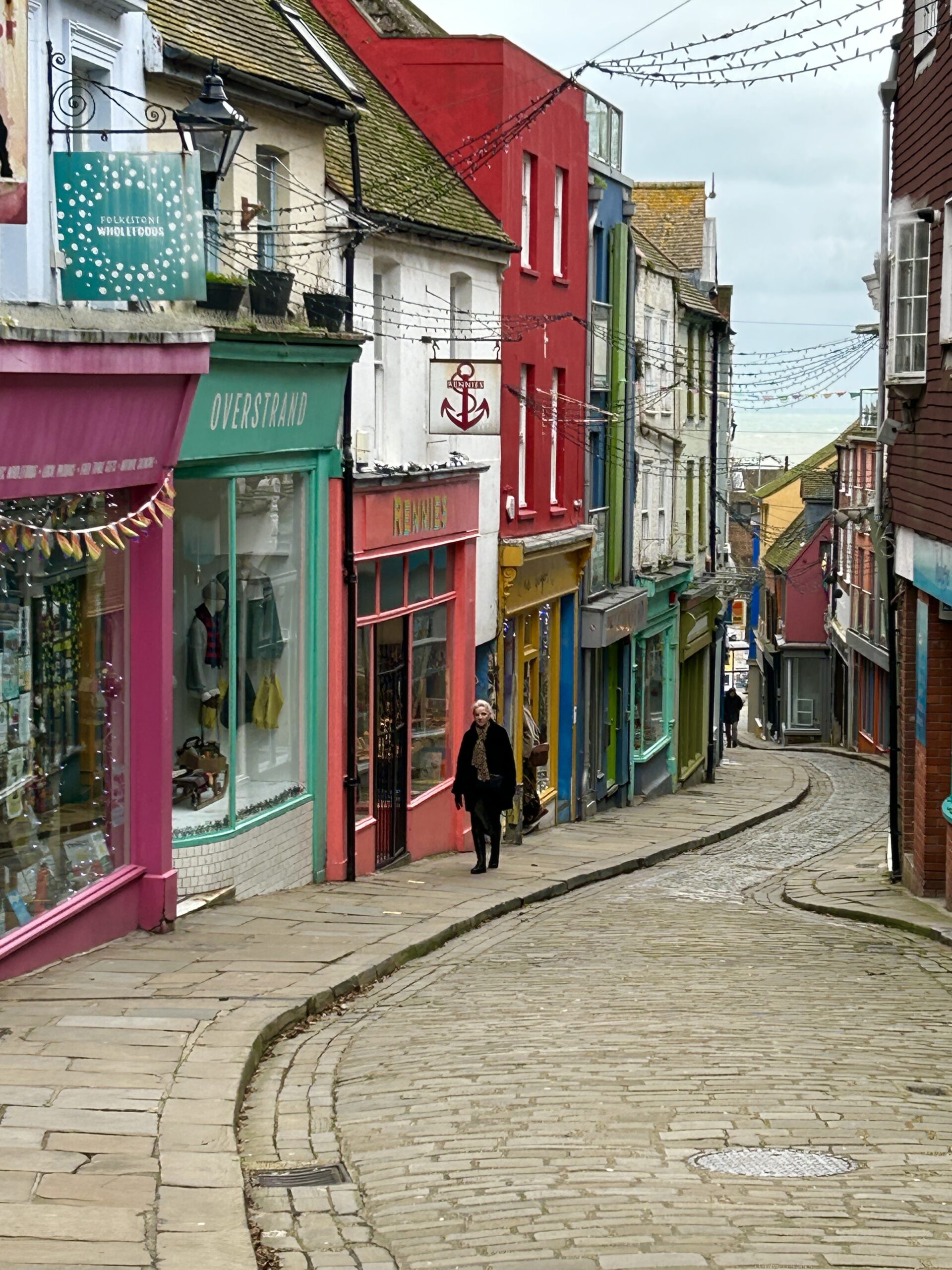
Folkestone’s Creative Quarter with adorable shops and art / Photo by Carolyn Ray
More to do during Christmas in Canterbury
- Canterbury Cathedral “A Festival of Carols” for people of all ages
- Canterbury Christmas Market, with local crafts, food and knick-knacks
- Canterbury Christmas Lights, with 6 miles of lights along the streets
- Philharmonia Orchestra: Brass At Christmas
- Beaney House of Art and Knowledge is free and includes artifacts from private collections.
Where to stay
There are many adorable bed and breakfasts. Avoid the area around the High Street as it can be noisy. Note there are two train stations in Canterbury, East and West, but both are a close walk to the High Street and historic area.
From St. Pancreas station in London, the train to Canterbury West takes less than an hour. There are nearby towns to explore along the English Channel, including Folkstone and Dover, just a short train ride away.
- Falstaff Inn: located outside the city gates. This historic hotel is welcoming and friendly, with a restaurant on site. Ask for a room on the second floor.
- Sun Hotel: With only seven rooms and a Mexican restaurant downstairs, this would be my choice for a future visit. (About £97 in December compared to £150 in summer).
- Find more places to stay here!
Where to eat
There are more than British pubs. Canterbury has a diverse culinary scene, with Turkish, Mediterranean, Japanese and of course English tea. I found reservations weren’t needed in the low season.
- Mister Miyagi Sushi for a change of pace
- Côte (French Cuisine), try the French Onion Soup!
- Tiny Tim’s Tearoom
- Shakespeare Wine Bar
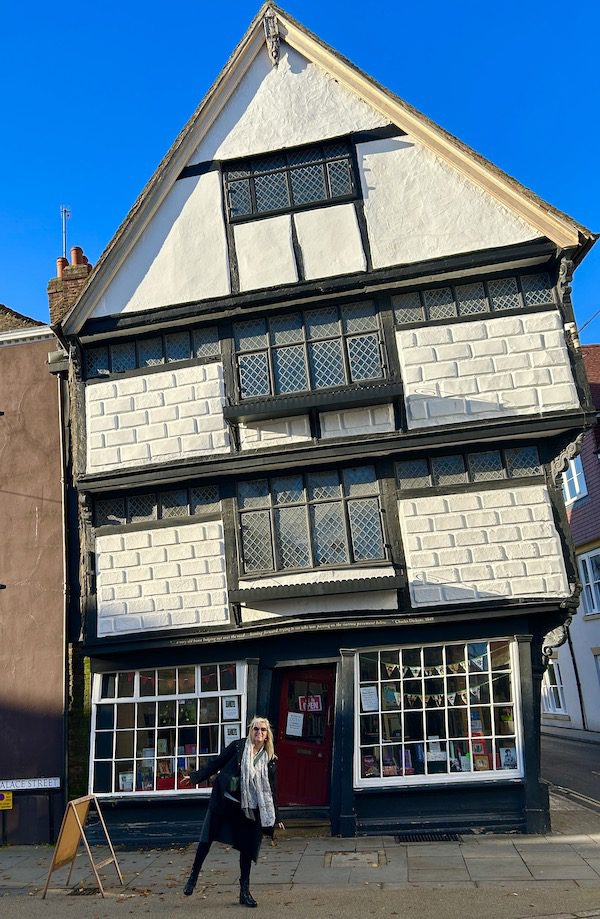
Canterbury’s crooked house, built in the 17th century, is actually a bookstore that raises money for the homeless / Photo by Carolyn Ray
For more Canterbury Suggestions
If you’d like to hire a local guide, email [email protected]
Visit Buttermarket Square by the Cathedral main gates.
Visit the official Canterbury website for more Christmas in Canterbury ideas. Check out Visit Kent for more ideas throughout the Kent area.
Disclaimer: We’re grateful to our tourism partners who provide opportunites for our writers to discover new places. For the second year in a row, Carolyn Ray was a guest of Visit Britain in December 2023. In November 2022, Carolyn visited Bristol and Bath with Visit Britain.
More to Discover From the UK
Finding Peace and Adventure in the Fable-like Town of Pitlochry, Scotland
With hiking trails that snake around in scenic spaghetti strands, the charming town of Pitlochry, Scotland has more urban walks, gardens, bookstores, pubs and sweet cafes than you’ll have an appetite for.
Thinking About Train Travel? Expert Tips from the Man in Seat 61
Train travel tips and advice from Mark Smith, the Man in Seat 61, to plan and prepare for train travel just about anywhere.
Hotels We’d Travel the World For, Just to Stay Again
Travel around the world with women-recommended places to stay that will take you to boutique hotels, guesthouses, retreats and more!

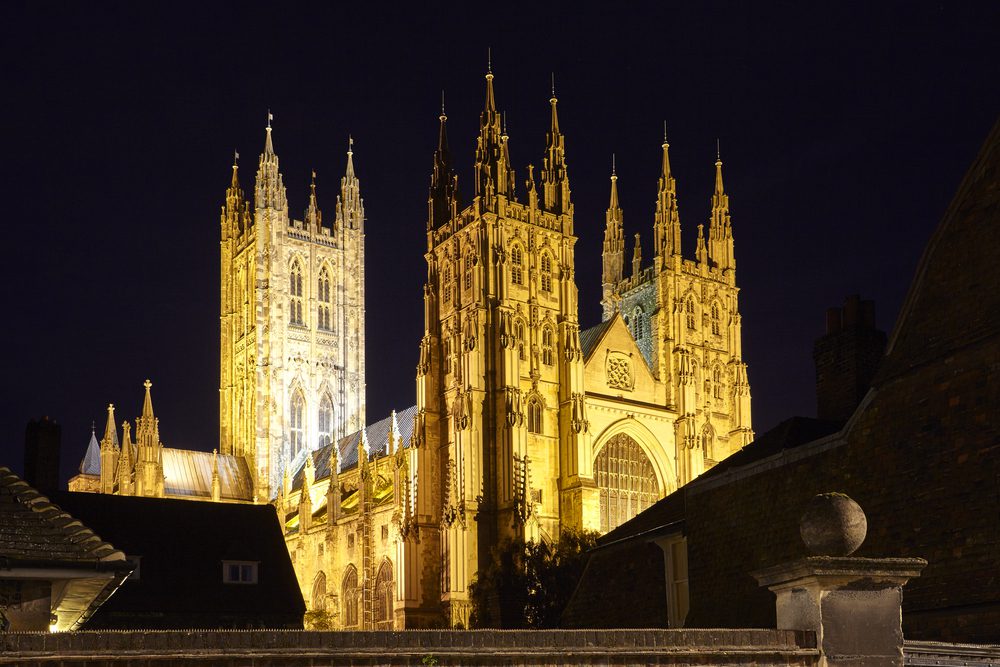



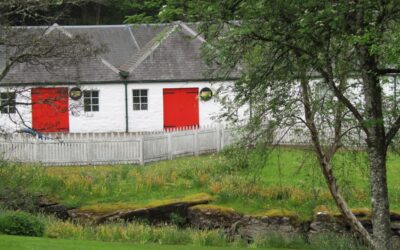


0 Comments
We always strive to use real photos from our own adventures, provided by the guest writer or from our personal travels. However, in some cases, due to photo quality, we must use stock photography. If you have any questions about the photography please let us know.
Disclaimer: We are so happy that you are checking out this page right now! We only recommend things that are suggested by our community, or through our own experience, that we believe will be helpful and practical for you. Some of our pages contain links, which means we’re part of an affiliate program for the product being mentioned. Should you decide to purchase a product using a link from on our site, JourneyWoman may earn a small commission from the retailer, which helps us maintain our beautiful website. JourneyWoman is an Amazon Associate and earns from qualifying purchases. Thank you!
We want to hear what you think about this article, and we welcome any updates or changes to improve it. You can comment below, or send an email to us at [email protected].